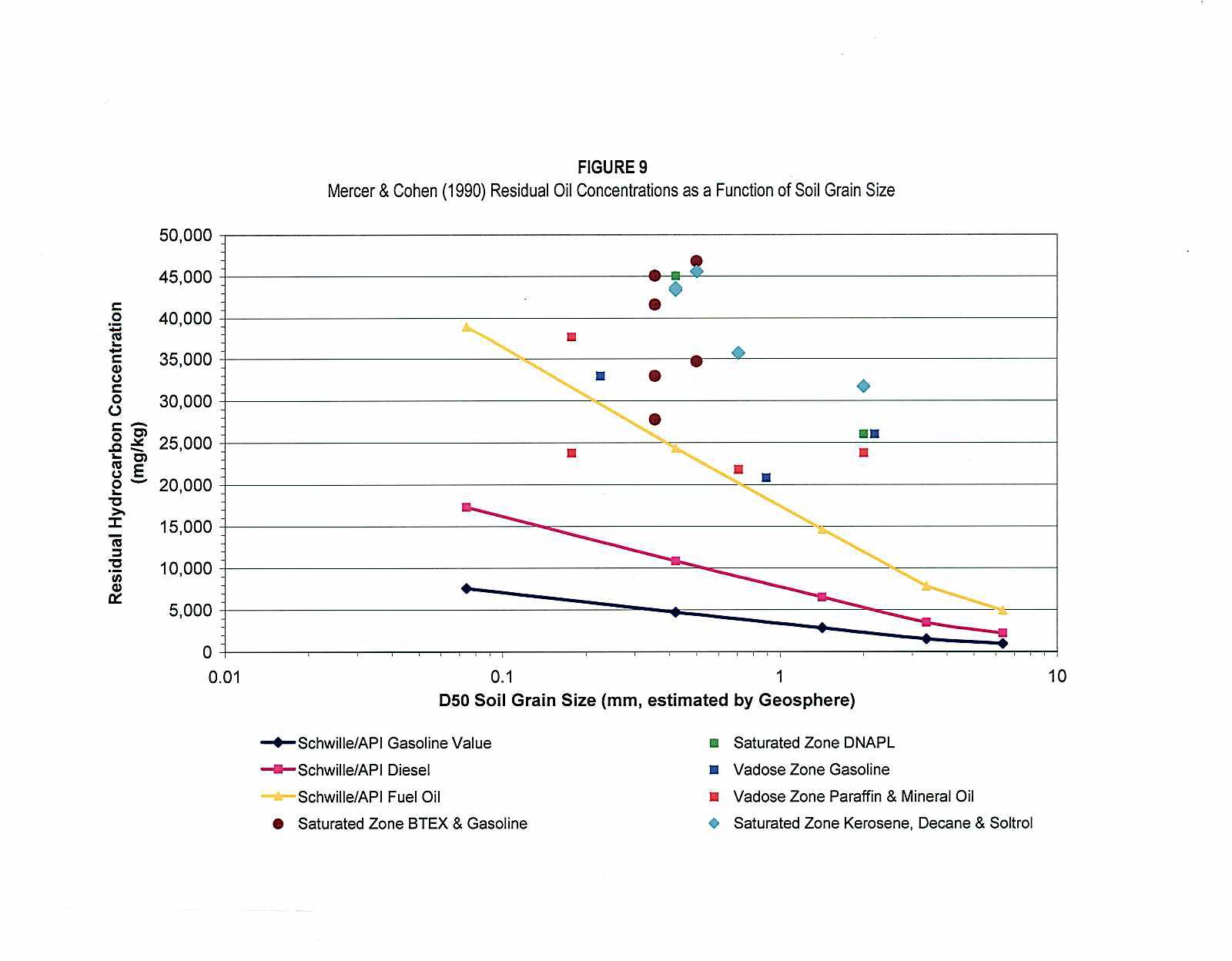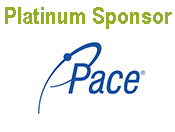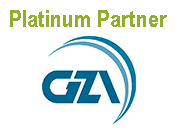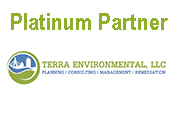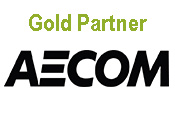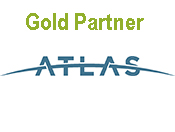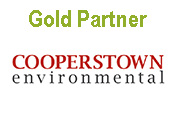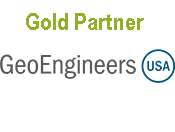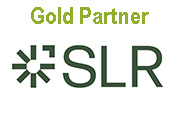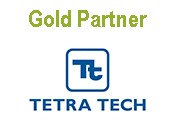2014 MCP Regulatory Changes: Characterizing and Closing Out NAPL Sites
By: Wesley E. Stimpson, Technical Practices Committee
The recent revisions to the MCP, most of which became effective June 20, 2014, substantially change how sites with NAPL are characterized and moved through the MCP process. In addition to some new terminology, MassDEP has embraced the fundamental scientific principles describing the behavior of fluid flow in porous media necessary to assess NAPL in subsurface strata. PRPs are now asked to provide multiple lines of evidence to support any endpoint conclusions, and MassDEP will be looking for more data than has historically been provided in support of closing out this type of disposal sites. The NAPL Upper Concentration Limit of 0.5 inches no longer needs to be met, and in fact is no longer available to be used as a component for obtaining an endpoint.
This overview is intended to give the reader a brief discussion of some of the major changes impacting the investigation and closure of NAPL sites, and to provide some resources for those who have not been intimately involved in this discussion over the past several years. The overview is organized as follows:
New Terminology
New Notification Requirements
Investigation and Response Action Performance Standard Changes
LSPA Observations
Useful References and Materials
References Provided by MassDEP
Example Residual Saturation “Lookup” Tables
References to the appropriate section of the 2014 MCP are provided so the reader may easily review the actual regulatory requirement.
As of the time of this posting, MassDEP had issued a Public Review Draft, dated July 1, 2014, of its intended guidance on investigating, assessing, understanding and addressing the presence and migration of LNAPL at disposal sites. The document is entitled, “Light Nonaqueous Phase Liquids (LNAPL) and the MCP: Guidance for Site Assessment and Closure – Policy #WSC-14-450” and can be found at http://www.mass.gov/eea/docs/dep/cleanup/laws/lnapldr.pdf.
The observations presented in this overview are not intended to represent the position of the MassDEP, or to be relied upon as guidance for complying with the new requirements of the MCP. When in doubt, consult the MCP, the listed technical resources, and knowledgeable professionals.
NEW TERMINOLOGY
From 310 CMR 40.0006
Nonaqueous Phase Liquid and NAPL each mean oil and/or hazardous material that is present in the environment as a separate phase liquid.
NAPL with Micro-Scale Mobility means a NAPL with a footprint that is not expanding, but which is visibly present in the subsurface in sufficient quantities to migrate or potentially migrate as a separate phase over a short distance and visibly impact an excavation, boring or monitoring well.
Non-Stable NAPL means a NAPL with a footprint that is expanding laterally or vertically by: (a) migrating along or within a preferred flow path; (b) discharging or periodically discharging to a building, utility, drinking water supply well, or surface water body; or (c) spreading as a bulk fluid through or from subsurface strata.
Source of OHM Contamination means:
(a) a point of discharge of OHM into the environment that may include, without limitation:
1. leaking storage tanks, vessels, drums and other containers
2. dry wells or wastewater disposal systems that are not in compliance with regulations governing discharges from those systems; or
(b) waste deposits, sludges, or impacted soil, sediment, or bedrock at or near a point of discharge or deposit of OHM into the environment containing sorbed OHM or NAPL that is contaminating surrounding environmental media via dissolution or volatilization processes; except that the downgradient leading edge of a plume of oil and/or hazardous material dissolved in and migrating with groundwater or as vapor-phase shall not, in and of itself, be considered a Source of OHM Contamination.
Conceptual Site Model or CSM meansa site-specific description of how contaminants entered the environment, how contaminants have been and may be transported within the environment, and routes of exposure to human and environmental receptors that provides a dynamic framework for assessing site characteristics and risk, identifying and addressing data gaps and managing uncertainty, eliminating or controlling contaminant sources, developing and conducting response action strategies, and evaluating whether those strategies have been effective in achieving desired endpoints. At sites at which NAPL is or may be present, this includes the body of fundamental scientific principles describing the behavior of fluid flow in porous media necessary to assess NAPL in subsurface strata.
NEW NOTIFICATION REQUIREMENTS
From310 CMR 40.0313
A measured thickness equal to or greater than 1/8 inch (0.01 feet) of LNAPL in a monitoring well, excavation, or subsurface depression within 30 feet of a School, Daycare or Child Care Center or occupied Residential Dwelling is a Condition of SRM and requires a 72-hr notice. - 310 CMR 40.0313(4)(f)3.
A measured thickness equal to or greater than 1/2 inch (0.04 feet) of NAPL in a groundwater monitoring well, excavation, or subsurface structure at a location greater than 30 feet from School, Daycare or Child Care Center or occupied Residential Dwelling requires a 72-hour notice. - 310 CMR 40.0313(1)
From 310 CMR 40.0315(4)
A measured thickness equal to or greater than 1/8 inch (0.01 feet) and less than 1/2 inch (0.04 feet) of NAPL in a groundwater monitoring well, excavation, or other subsurface structure requires a 120 day notice.
Note: The 30 foot distance in 40.0313 is measured both horizontally and vertically. Groundwater depths greater than 30 feet are not reportable, even if they are within 30 feet horizontally
INVESTIGATION AND RESPONSE ACTION PERFORMANCE STANDARD CHANGES
Site Characterization
The revisions emphasize the need for complete data sets to define the nature and extend of the contamination being evaluated in accordance with the Conceptual Site Model approach. These requirements show up in the Phase I and II Report content descriptions.
From 310 CMR 40.0483(1)(e)5
Phase I Report - information and details on NAPL, if present or suspected, including NAPL stability and the approximate horizontal and vertical extent of NAPL contamination
From 310 CMR 40.0835(4)(f)
Phase II Report - Nature and Extent of Contamination, including a characterization of the nature and vertical and horizontal extent of oil and/or hazardous material in the environment, including any and all source(s), the presence, distribution, and stability of any NAPL
Revisions to Closure Criteria
From 310 CMR 40.1003(7) NAPL
A Permanent or Temporary Solution shall not be achieved … unless and until response actions are taken to adequately assess the nature, extent, and mobility of the NAPL, and, where necessary, remedial actions are taken to adequately contain or remove such NAPL. Such response actions shall ensure:
(a) for a Permanent Solution, (i) Non-Stable NAPL is not present under current site conditions and for the foreseeable future, and (ii) all NAPL with Micro-Scale Mobility is removed if and to the extent feasible based upon consideration of CSM principles; (b) for a Temporary Solution, all Non-Stable NAPL and NAPL with Micro-Scale Mobility is removed and/or controlled if and to the extent feasible.
Demonstrations Needed for Permanent Solution –
From 310 CMR 40.0006
Non-Stable NAPL is not considered to be present under current site conditions and for the foreseeable future if the NAPL footprint is not expanding laterally or vertically by:
(a) migrating along or within a preferred flow path;
(b) discharging or periodically discharging to a building, utility, drinking water supply well, or surface water body; or
(c) spreading as a bulk fluid through or from subsurface strata.
and
From 310 CMR 40.1003(7)
NAPL with Micro-Scale Mobility is removed if, and to the extent feasible based upon consideration of CSM principles.
In addition, an Activity and Use Limitations shall be required:
From 310 CMR 40.1012(2)(d)
At disposal sites for which a Permanent Solution is achieved and NAPL with Micro-Scale Mobility is present.
LSPA OBSERVATIONS
The additional requirements added to Phase I and Phase II should be read as “soil contamination data, soil property data and LNAPL property data needed.” In addition to a demonstration that a condition of No Significant Risk exists based on soil concentration data for current and foreseeable exposure points, multiple lines of evidence will required to demonstrate the absence of Non Stable LNAPL and the option to leave residual NAPL with Micro-Scale Mobility.
After the LSP has demonstrated adequate characterization of the subsurface setting and the nature and extent of the NAPL contamination, and has measured exposure point concentrations and demonstrated a condition of No Significant Risk, then he or she will need to provide data and other lines of evidence to demonstrate the absence of Non-Stable NAPL.
Some general questions to answer, as part of this demonstration, include:
- How representative is the NAPL and soil data set?
- Is the NAPL in a naturally deposited soil and is that deposit homogeneous? Are there sufficient data to address the variability of the soil over a reasonable distance?
- What is the NAPL saturation profile?
- Is NAPL at, or less than its residual saturation/concentration in soil?
- What are the effective and relative permeabilities of NAPL-contaminated media?
- How do the values of relative permeabilities compare to site conditions?
- Are well pore entry pressures (Ref 6) exceeded at monitoring well locations?
To evaluate whether preferred pathways and sensitive receptors are expected:
- Are there discharges of NAPL to a building, utility, drinking water supply well, or surface water body nearby?
- Have there been historic NAPL impacts to these receptors?
- Where are utilities (horizontally and vertically) relative to the NAPL?
- Is NAPL in fill, and what is the fill quality and heterogeneity?
- Are active pathways currently present?
- What have been past preferred pathways and have they been mitigated?
And finally, to assess whether Micro-Scale Mobility is present and if an AUL is required, consider undertaking one or more of these approaches involving CSM principles:
- The use of Decline Curve Analysis
- An evaluation of NAPL transmissivity
- A demonstration of residual saturation/concentration
- An evaluation of well pore entry pressure
The reference list that follows will help you understand these terms and what might be involved in assembling the required.
For a quick start, it is suggested that you look at References numbered 1, 2, 3, 6, 13, 15, and 16.
USEFUL REFERENCES AND MATERIALS
Recommended Reading
The application of multi-fluid flow through porous media to NAPL (primary LNAPL) releases into the shallow subsurface has developed over the last 15 or so years. Prior to this application, the theories had been developed and refined for the petroleum investigation and production industry. As a result, there is not one clearly developed protocol. To complicate matters, there is not even a uniform set of technical terms used in the references provided below. But with a little bit of an open mind and individual evaluation of the pros and cons of the theories provided, one can develop a general understanding of the science and the requirements necessary to apply it to a specific situation.
In the literature, the application of these principles to LNAPL release sites tends to fall into two camps; those who advocate that LNAPL plume stability endpoints should be evaluated looking at the soil – LNAPL interactions, and those who advocate that well – LNAPL interactions should control. Some advocates feel that the satisfaction of both interactions is necessary. This last approach is what the MassDEP has decided is appropriate under the MCP with the introduction of the terms Non-Stable NAPL and Micro-scale Mobility. You will not find these terms, however, used in any non-MassDEP reference.
LSPA White Papers and Presentations
1. LNAPL and the Massachusetts Contingency Plan, Part I, Prepared by the LSP Association Technical Practices Committee, April 2005
http://www.lspa.org/assets/documents/wp-LNAPL-PartI040505.pdf
2. LNAPL and the Massachusetts Contingency Plan, Part II, Prepared by the LSP Association Technical Practices Committee, July 2008
http://www.lspa.org/assets/documents/wp-LNAPLPartII.pdf
3. LNAPL – Assessment and Extraction Technologies, LSPA Member Meeting Presentation December 2013
MassDEP Postings
4. Light Nonaqueous Phase Liquids (LNAPL) and the MCP: Guidance for Site Assessment and Closure – Policy #WSC-14-450, Public Review Draft July 1, 2014
http://www.mass.gov/eea/docs/dep/cleanup/laws/lnapldr.pdf
5. MassDEP Regulatory Reform Blog
http://mcpregreform.wordpress.com/
Alaska Department of Environmental Conservation (ADEC)
6. Maximum Allowable Concentration, Residual Saturation, and Free-Product Mobility Technical Background Document and Recommendations; Prepared for Alaska Statement of Cooperation Working Group; September 2006.
http://dec.alaska.gov/spar/csp/docs/soc/4_max_allow_conc.pdf
British Columbia
7. Report on: Approaches and Methods for Evaluation of Light non-Aqueous – Hydrogeological Assessment Tools Project; Submitted to: Ministry of Environment; February 2006.
http://www.sabcs.chem.uvic.ca/LNAPL%20Guidance%2002-15-06%20rev.pdf
EPA Superfund Technology Support Center for Ground Water Technology Innovation Office
8. Ground Water Issue, Light Nonaqueous Phase Liquids, Charles J. Newell, Steven D. Acree, Randall R. Ross, and Scott G. Huling, EPA/540/S-95/500.
http://www.epa.gov/superfund/remedytech/tsp/download/lnapl.pdf
MassDEP Presentations
9. Characterization of #2 Fuel Oil Spills, John Fitzgerald, MassDEP, October 2013.
http://www.mass.gov/eea/docs/dep/cleanup/jfos613t.pdf
10. Non-Aqueous Phase Liquids (LNAPL/DNAPL) & Source Elimination/Control(and update on LNAPL Guidance), MassDEP 2014 MCP Change Training, Ken Marra, P.E.
http://www.mass.gov/eea/docs/dep/cleanup/compliance/napltrkm.pdf
Interstate Technology & Regulatory Council (ITRC)
11. Evaluating LNAPL Remedial Technologies for Achieving Project Goals, December 2009.
http://www.itrcweb.org/Guidance/GetDocument?documentID=48
Helpful Materials
LNAPL Transmissivity
12. Light Non-Aqueous Phase Liquid (LNAPL) Resource Center (including: Interactive LNAPL Guide; LNAPL Distribution and Recovery Model (LDRM); and LNAPL Transmissivity Workbook - Calculation of LNAPL Transmissivity from Baildown Test Data.)
http://www.api.org/environment-health-and-safety/clean-water/ground-water/lnapl\
13. Standard Guide for Estimation of LNAPL Transmissivity, ASTM E2856-13(revised 2013). [Must be purchased from ASTM]
http://www.astm.org/Standards/E2856.htm
14. Use and Application of ASTM Standard Guide Standard Guide for Estimation for Estimation of LNAPL Transmissivity (ASTM E2856 ASTM E2856-11), Christopher Pearson, P.E., AECOM
http://ipec.utulsa.edu/Conf2012/Papers_Presentations/Pearson.pdf
Residual Saturation
15. Residual Saturation: What is it? How is it Measured? How Should We Use it?, Adamski, Mark, Kremesec, Victor, and Charbeneau, Randall, Charbeneau, National Ground Water Association and American Petroleum Institute, 20th Conference, Petroleum Hydrocarbons and Organic Chemicals in Groundwater, 2003
http://www.clu-in.org/conf/itrc/iuLNAPL/030513_residual.pdf
Residual Saturation Lookup Tables
See examples at end of References Provided by MassDEP below
LCSM Approach Components
16. Appendix C of Evaluating LNAPL Remedial Technologies for Achieving Project Goals, December 2009
http://www.itrcweb.org/Guidance/GetDocument?documentID=48
Analytical Methods for Indicators of Residual Saturation, Intrinsic Permeability and Other Parameters
17. Terminology definitions
http://www.ptslabs.com/documents/GenDef.pdf
18. Methods for determining inputs to environmental petroleum hydrocarbon mobility and recovery models, American Petroleum Institute Publication No. 4711, , Sale, 2001
http://www.api.org/ehs/groundwater/upload/4711.pdf
19. Overview of Specialized Testing for Permeability Derived for Oil Field
http://petrowiki.org/Measurement_of_capillary_pressure_and_relative_permeability
Laboratories Available for Specialized Testing
PTS Laboratories Inc., Texas
Core Laboratories, Inc. California
REFERENCES PROVIDED BY MASSDEP
Interstate Technology & Regulatory Council (ITRC)
Archived On-Line Classes:
LNAPL Training Part 1: An Improved Understanding of LNAPL Behavior in the Subsurface - State of Science vs. State of Practice (last uploaded March 4, 2014)
http://www.itrcweb.org/Training#LNAPLPart1
LNAPL Training Part 2: LNAPL Characterization and Recoverability - Improved Analysis - Do you know where the LNAPL is and can you recover it? (last uploaded March 6, 2014)
http://www.itrcweb.org/Training#LNAPLPart2
LNAPL Training Part 3: Evaluating LNAPL Remedial Technologies for Achieving Project Goals
http://www.itrcweb.org/Training#LNAPLpart3 (last uploaded Sept 24, 2013)
Tech/Reg Guidance Document:
Evaluating LNAPL Remedial Technologies for Achieving Project Goals; December 2009.
http://www.itrcweb.org/Documents/LNAPL-2.pdf
American Petroleum Institute (API)
Brost et al.; Non-Aqueous Phase Liquid (NAPL) Mobility Limits in Soil; API Bulletin No. 9; June 2000.
http://www.api.org/ehs/groundwater/upload/09_bull.pdf
Light Non-Aqueous Phase Liquid (LNAPL) Resource Center (including: Interactive LNAPL Guide; LNAPL Distribution and Recovery Model (LDRM); and LNAPL Transmissivity Workbook - Calculation of LNAPL Transmissivity from Baildown Test Data.)
http://www.api.org/environment-health-and-safety/clean-water/ground-water/lnapl\
American Society for Testing and Materials (ASTM International)
ASTM E2856-13 Standard Guide for Estimation of LNAPL Transmissivity (revised 2013) [Needs to be Purchased]
http://www.astm.org/Standards/E2856.htm
ASTM D7242/D7242M-06(2013)e1 Standard Practice for Field Pneumatic Slug (Instantaneous Change in Head) Tests to Determine Hydraulic Properties of Aquifers with Direct Push Groundwater Samplers (revised 2006, re-approved 2013) [Needs to be Purchased]
http://www.astm.org/Standards/D7242.htm
Adamski, Mark, P.G.
Adamski, Mark, Kremesec, Victor, and Charbeneau, Randall, Charbeneau Residual Saturation: What is it? How is it Measured? How Should We Use it?, National Ground Water Association and American Petroleum Institute, 20th Conference, Petroleum Hydrocarbons and Organic Chemicals in Groundwater, 2003.
Adamski, et. al., LNAPL in Fine-Grained Soils: Conceptualization of Saturation, Distribution, Recovery, and Their Modeling, Groundwater Monitoring and Remediation, Vol 25, no.1, Winter 2005 pages 100–112.
British Columbia Ministry of Environment
PROTOCOL 16 FOR CONTAMINATED SITES: Determining the Presence and Mobility of Nonaqueous Phase Liquids and Odorous Substances; May 2010.
http://www.env.gov.bc.ca/epd/remediation/policy_procedure_protocol/protocols/pdf/protocol-16.pdf
Report on: Approaches and Methods for Evaluation of Light non-Aqueous – Hydrogeological Assessment Tools Project; Submitted to: Ministry of Environment; February 2006.
http://www.sabcs.chem.uvic.ca/LNAPL%20Guidance%2002-15-06%20rev.pdf
Alaska Department of Environmental Conservation (ADEC)
Maximum Allowable Concentration, Residual Saturation, and Free-Product Mobility Technical Background Document and Recommendations; Prepared for Alaska Statement of Cooperation Working Group; September 2006.
http://dec.alaska.gov/spar/csp/docs/soc/4_max_allow_conc.pdf
Texas Commission on Environmental Quality
Risk-Based NAPL Management; RG-366/TRRP-32; Revised July 2013.
http://www.tceq.texas.gov/publications/rg/rg-366_trrp_32.html/at_download/file
EXAMPLE RESIDUAL SATURATION “LOOKUP” TABLES
There are various sources of information providing examples of soil residual saturation/concentrations. All sources have qualifications as to what the data represents and how they were obtained. Three examples are provided below to demonstrate the variablity in the published data. You can see how soil residual saturation is dependent on NAPL type as well as soil type. However, the published data can be used as an order-of-magnitude parameter in undertaking your initial NAPL mobility evaluation studies.
Non-Aqueous Phase Liquids (LNAPL/DNAPL) & Source Elimination/Control (and update on LNAPL Guidance), MassDEP 2014 MCP Change Training, Ken Marra, P.E.
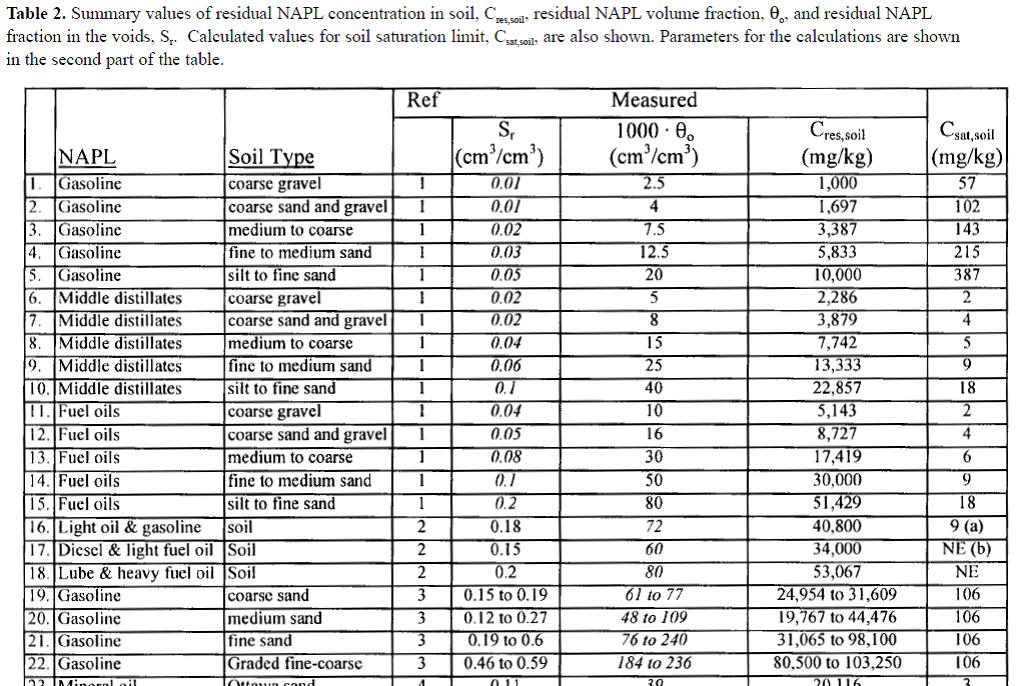
Ohio EPA-DERR, Number: DERR-00-DI-033
ISSUED: September 22, 2004, STATUS: Final
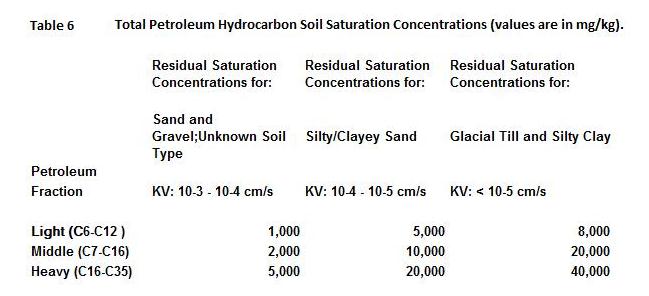
Where: “mg/kg” means milligrams per kilogram,“KV” means vertical hydraulic conductivity of the unsaturated soil, “cm/s” means centimeters per second, and “Cx” means carbon chain length.
Maximum Allowable Concentration, Residual Saturation, and Free-Product Mobility Technical Background Document and Recommendations; Prepared for Alaska Statement of Cooperation Working Group; September 2006.
